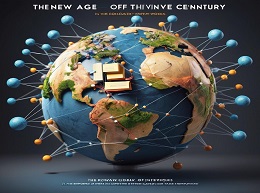The New Age of Innovation: Driving Cocreated Value Through Global Networks

Unveiling Innovation: A Detailed Review of "The New Age of Innovation: Driving Cocreated Value Through Global Networks"
In "The New Age of Innovation: Driving Cocreated Value Through Global Networks," authors C.K. Prahalad and M.S. Krishnan present a revolutionary framework for understanding and harnessing the power of innovation in the 21st century. This book delves into how businesses can thrive in a rapidly evolving global landscape by leveraging global networks and co-creating value with customers. This review explores the book's key themes, insights, and practical examples, offering a comprehensive guide for readers eager to innovate in today’s interconnected world.
The Framework of Innovation
Prahalad and Krishnan introduce a compelling model that emphasizes two core principles: N=1 and R=G. These principles serve as the foundation for understanding how businesses can drive innovation and value creation.
N=1: Individual-Centric Value Creation
The N=1 principle asserts that the primary focus of innovation should be on the individual customer. Each customer's unique needs and preferences should drive the creation of tailored experiences and solutions.
Example: Amazon exemplifies the N=1 principle by utilizing personalized recommendations. Their sophisticated algorithms analyze individual browsing and purchasing behavior to offer customized product suggestions, enhancing the user experience and driving sales.
R=G: Leveraging Global Resources
The R=G principle highlights the importance of leveraging resources from a global network. Companies should utilize diverse resources ranging from suppliers and partners to technologies and data available worldwide to innovate and deliver value.
Example: Apple’s iPhone production is a testament to the R=G principle. By sourcing components and expertise from around the globe, Apple ensures high-quality production and innovation while maintaining efficiency and cost-effectiveness.
Strategic Imperatives for the New Age
The authors identify several strategic imperatives that businesses must embrace to thrive in the new age of innovation. These imperatives are crucial for aligning organizational strategies with the N=1 and R=G framework.
Embracing Digital Technology
Digital technology is a cornerstone of modern innovation. Prahalad and Krishnan emphasize the need for businesses to integrate digital tools and platforms to enhance connectivity, data collection, and customer engagement.
Example: Netflix's transition from a DVD rental service to a digital streaming platform revolutionized the entertainment industry. By leveraging digital technology, Netflix provides personalized viewing experiences based on user data, setting a new standard for media consumption.
Building a Networked Organization
To harness the power of global networks, businesses must evolve into networked organizations. This involves fostering collaboration across internal and external networks to drive innovation and agility.
Example: Procter & Gamble (P&G) utilizes an open innovation model called Connect + Develop, which encourages collaboration with external partners and innovators. This approach has led to numerous successful product innovations, including the Swiffer cleaning system.
Fostering a Culture of Innovation
A culture that encourages experimentation, risk-taking, and continuous learning is essential for innovation. Prahalad and Krishnan advocate for creating an environment where employees feel empowered to innovate and contribute to value creation.
Example: Google’s 20% time policy, which allows employees to spend 20% of their work time on projects they are passionate about, has led to the development of groundbreaking products like Gmail and Google News.
Case Studies: Real-World Applications
The book is rich with case studies that illustrate how leading companies have successfully implemented the principles of N=1 and R=G to drive innovation and create value.
Case Study: Zara
Zara, the global fashion retailer, exemplifies the N=1 principle by focusing on customer-centric innovation. Zara’s rapid supply chain allows them to respond swiftly to fashion trends and customer preferences, ensuring that their stores are always stocked with the latest styles.
Example: Zara’s use of real-time data from its stores to inform design and production decisions enables the company to launch new products quickly, often within weeks of identifying a trend. This agility keeps customers engaged and drives continuous growth.
Case Study: Infosys
Infosys, a leading IT services company, leverages the R=G principle through its global delivery model. By distributing work across its global network of delivery centers, Infosys can access diverse talent pools and deliver high-quality services efficiently.
Example: Infosys’s Global Delivery Model (GDM) allows the company to provide 24/7 service to clients worldwide, utilizing teams in different time zones to maintain continuous operations and innovation.
Challenges and Opportunities
Prahalad and Krishnan acknowledge the challenges businesses face in adopting the N=1 and R=G principles. These include managing the complexity of global operations, ensuring data security, and maintaining a customer-centric focus amid rapid technological changes.
Overcoming Complexity
Managing a global network of resources can be complex. Businesses must develop robust systems and processes to coordinate activities across different regions and functions.
Example: IBM’s Smarter Planet initiative integrates data from various sources to improve decision-making and operational efficiency across its global network. This holistic approach helps IBM manage complexity while driving innovation.
Ensuring Data Security
As companies collect and utilize vast amounts of customer data, ensuring data security and privacy becomes paramount. Businesses must implement stringent security measures to protect sensitive information.
Example: Facebook’s investment in advanced security technologies and protocols aims to protect user data while enabling personalized experiences. Despite facing challenges, Facebook’s efforts highlight the importance of prioritizing data security in the digital age.
Embracing the New Age of Innovation
"The New Age of Innovation: Driving Cocreated Value Through Global Networks" is an essential read for business leaders and entrepreneurs seeking to navigate the complexities of the modern innovation landscape. Prahalad and Krishnan’s principles of N=1 and R=G provide a clear and actionable framework for creating value in a rapidly evolving global market.
By focusing on individual customer needs and leveraging global resources, businesses can drive continuous innovation and maintain a competitive edge. The strategic imperatives outlined in the book, supported by real-world examples and case studies, offer practical insights for implementing these principles.
Ultimately, "The New Age of Innovation" challenges businesses to rethink their approach to innovation and value creation. It encourages a shift towards customer-centricity and global collaboration, paving the way for sustainable growth and success in the 21st century. This book is not just a guide; it is a blueprint for thriving in the new age of innovation.













